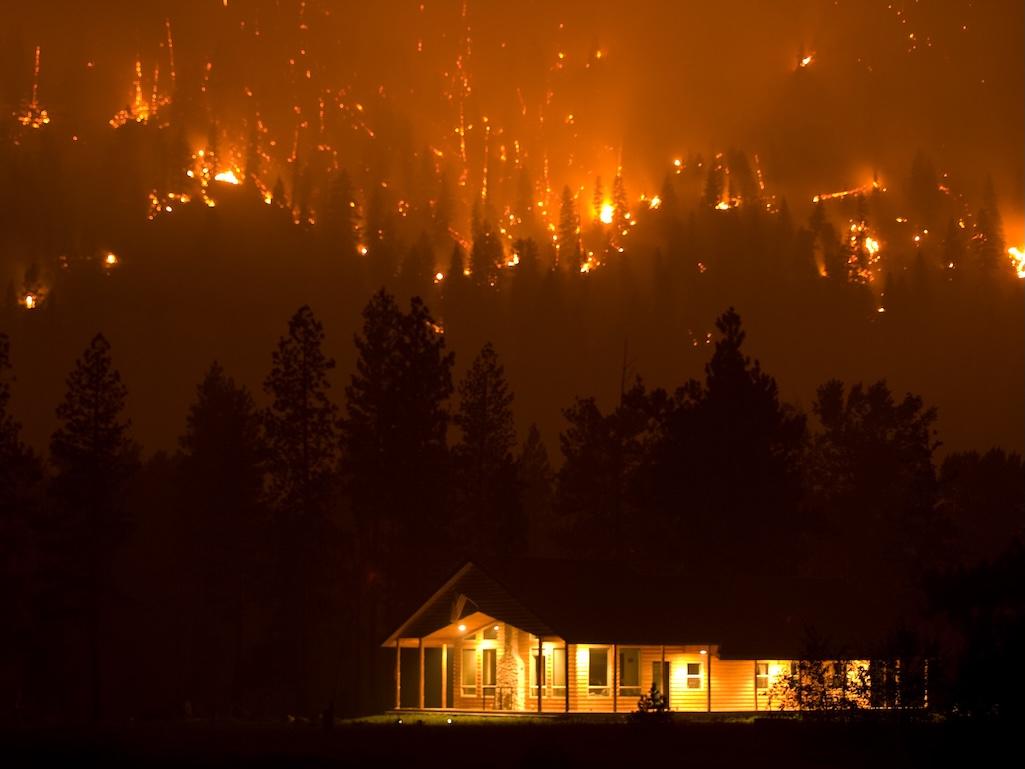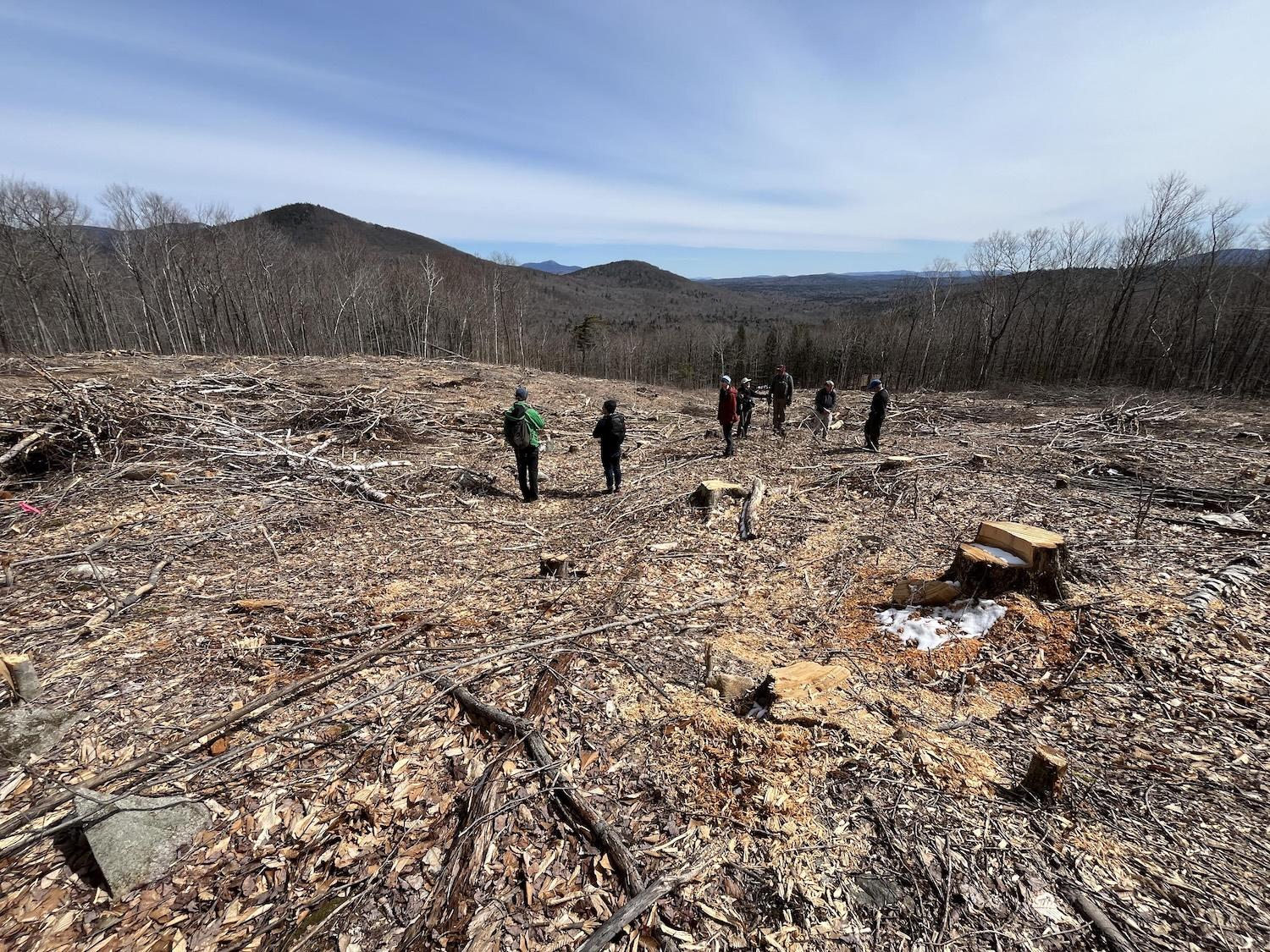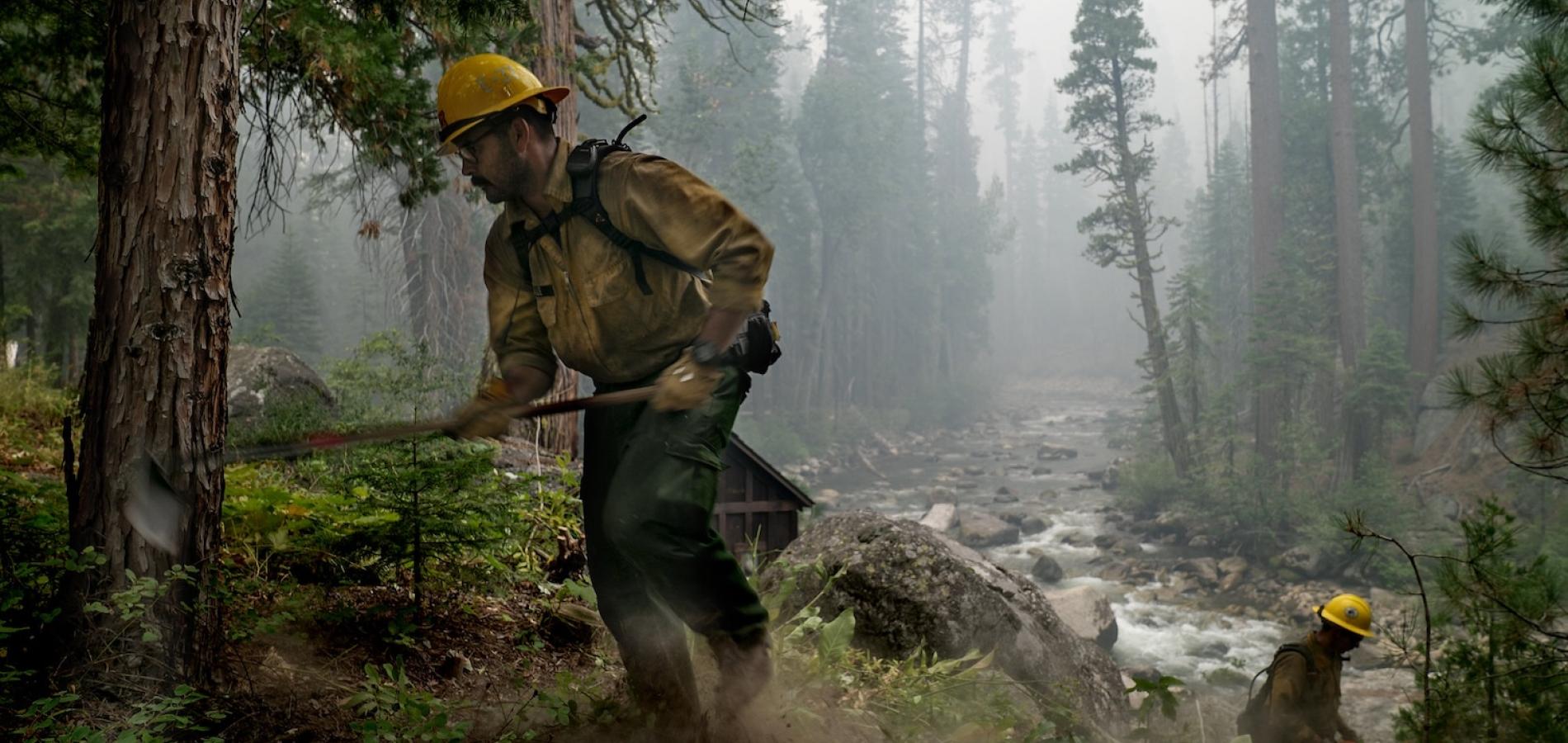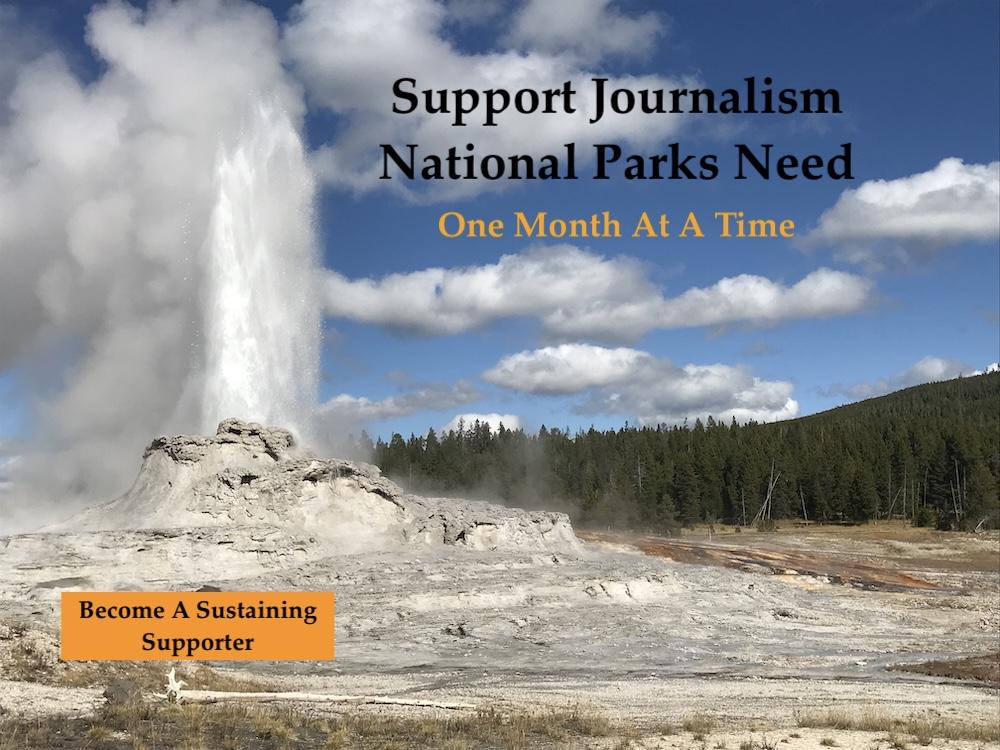Efforts to blunt the ferocity and destruction of wildfires are dividing conservation advocates over proposals that would sidetrack science and allow for less analysis under the country’s hallmark environmental law. Critics fear that approach could accelerate unnecessary logging in national forests.
Global warming and drought have intensified wildfires; but ramping up timber production on federal land as President Trump is ordering would fuel the climate crisis, some scientists say. And as Congress members shepherd legislation to reduce vegetation that feeds infernos, critics foresee a gateway to unnecessary logging beyond wildfire resilience efforts.
Two distinct themes are advancing: Trump’s executive orders directing more logging to serve “jobs and prosperity” and reduce imports; and congressional proposals for forest thinning and prescribed burns to limit wildfire destruction that threatens communities.
Their intersection: Both center on what activities should be permitted, and how quickly, on federal forest land, the once-prolific logging arenas that today serve a range of recreation, wilderness, watershed protection, grazing, and wildlife habitat purposes, while harvesting a fraction of the U.S. timber. Privately owned forests produce some 90 percent of the nation's timber.
Controlled burns and mechanical forest thinning are standard tools for public and private forests. But Trump’s drive to exploit federal land resources in the name of fire protection and economic development — his order ties wildfire destruction to “our inability to fully exploit our domestic timber supply” — has created a stew of concerns and suspicion along with urgency. In Congress, a push for more and faster wildfire protection has produced bipartisan legislation in both houses that would expand use of “categorical exclusions,” which are used under the National Environmental Policy Act to reduce environmental review when a project is deemed to have no significant environmental impact.
“Our communities can’t afford to wait for the political winds to change to find solutions to address the ever-increasing threat of wildfires,” said Sen. Alex Padilla, D-California, who’s sponsoring the Senate version of the Fix Our Forests Act with Colorado Democrat John Hickenlooper and Republican Sens. John Curtis of Utah and Tim Sheehy of Montana.
“My bipartisan bill avoids unnecessary delays to urgently needed wildfire risk reduction efforts, while at the same time aims to protect our wildlife habitat using responsible, science-based forest management,” Padilla told the Traveler, referencing the great swaths of California wildlands ravaged by runaway wildfires in recent years, and the flattening of urban Los Angeles neighborhoods this year.

Trinity Ridge Fire, Pine and Featherville, Idaho, Boise National Forest, August, 2012. (Forest Service photo by Kari Greer
Padilla’s fellow Democratic California senator, Adam Schiff, was skeptical at a Tuesday hearing of the Senate Agriculture, Nutrition and Forestry Committee. Going to the heart of critics’ worries, he said he wanted to “make sure that this is really about fire mitigation and not just about timber harvesting.”
Some timber harvest will be useful “in terms of making our forests more resilient," Schiff said, “but of course there will be interest in the timber industry to go beyond that and harvest timber having nothing to do with fire mitigation. That is not my priority."
Conservation groups are split on the Fix Our Forest Act, or FOFA.
“If we log those old growth and large and mature trees, it's not only directly worse for fire, but those are the most important trees for carbon sequestration,” said Chris Westfall, senior government relations legislative counsel for Defenders of Wildlife, which is among more than 100 conservation organizations opposing FOFA. “Short-term interests aren't achieved, and the long-term interest could actively be making climate change worse,” he added.
But others see wildfires burning up the very habitat they seek to protect, and cite a need for thinning to slow the flames.
The National Parks Traveler Is Interested In Hearing From National Park Service And Interior Department Employees On Changes To Their Agencies
Reach Editor Kurt Repanshek at [email protected] or via Signal at ParksTraveler.52
“Forest Service research shows that the greatest threat to old growth trees in the dry forests of the Western US is catastrophic wildfire,” said Eric Holst, associate vice president for forestry for Environmental Defense Fund( EDF), which supports the Senate version of FOFA. “If you care about old growth, you need to be concerned about reducing catastrophic wildfire and increasing beneficial fire.”
“We know the solution — it’s a combination of prescribed fire, ecological thinning, and firebreaks," he said.
FOFA legislation seeks to more quickly launch those resiliency projects and reduce wildfire fuel that’s built up in the forests, by shortcutting some procedures around environmental review and litigation.
EDF, the National Audubon Society, The Nature Conservancy and many other environmental groups are lined up behind the Senate bill, citing guardrails that tighten environmental and public participation weaknesses they saw in the House version. They say that existing individual forest plans still have to be followed, including any provisions on what size trees can be cut.
“In pure timber management, you're cutting the trees to produce wood. In wildfire resilience management, you're carefully thinning a select number of trees to restore forests to a healthier condition,” said Holst. The Senate bill “does a good job of limiting expedited environmental review processes and procedures to only those projects that are dedicated to wildfire resilience.”

A 9-acre "patch cut" that was logged earlier this year as a part of the White Mountain National Forest's Sandwich Vegetation Management Project/Zack Porter, Standing Trees
The conservationist opponents couldn’t disagree more.
"Only a subset of forest plans contain any safeguards at all for old-growth forests or for individual large trees, and no protections afforded to ’mature’ or future old-growth forests, anywhere in the National Forest System,” Zack Porter, executive director of Vermont-based advocacy group Standing Trees, said in an interview. Where old growth is prioritized, he said, the parameters are “often designed to minimize what is protected.”
Kya Marienfeld, attorney for the Southern Utah Wilderness Alliance attorney, said that FOFA “erodes bedrock environmental protections, risking further degradation of treasured landscapes and leaving communities more vulnerable to destructive fires, not less. Equally troubling, the bill would sideline science while stripping transparency and public input from restoration decisions-precisely the wrong approach for effective, enduring wildfire prevention and ecosystem health.”
Hanging over the whole debate is President Trump’s dramatic reduction in the federal workforce, including Forest Service personnel needed for projects that congressional legislation envisions for wildfire resilience. On Tuesday, the associate chief of the Forest Service, Chris French, told the Senate committee hearing that said the agency will have to rely more heavily on state and private partners just to continue its current pace of wildfire protection treatment because money from the Biden-era infrastructure legislation will end.
Trimming And Burning In Forests
In the House, the Fix Our Forests bill was introduced by U.S. Rep. Bruce Westerman, an Arkansas Republican, and Rep. Scott Peters, D-California. It quickly passed in January on a 279-141 bipartisan vote as Los Angeles communities were burning. The Senate has not yet voted on its version.
Westerman sees his measure as a commonsense approach to both provide communities a measure of security from wildfires while also fueling their economies through logging. The bill "will restore forest health, increase resiliency, and help protect communities located in the wildland urban interfaces,” Westerman said earlier this year, adding that Americans must be “good stewards of our resources,” and “the Fix Our Forests Act can be the catalyst of better forest management which will result in the prevention and mitigation of uncontrollable wildfires."
Asked about criticisms from environmental groups who support the Senate version as more environmentally sound, Westerman sent the Traveler a statement that did not respond to those points but said he looked forward to "bicameral work on this legislation."
Both Senate and House versions would establish “fireshed management areas” consisting of the top 20 percent of Forest-Service-delineated firesheds based on wildfire risk exposure to communities.

Mechanical thinning in the Lassen National Forest in Northern California during the 2021 Dixie Fire/USFS, Cecilio Ricardo
Agencies involved in the designation would pre-position firefighting equipment and personnel both to battle fires and work to restore the burned area with an eye towards preventing conversion of the forest to different tree species.
Fireshed management projects would include hazardous fuels reduction, removing hazard trees such as those dead or dying, and thinning out forests. Work would have to be allowed under existing forest plans that govern each national forest. FOFA also would allow increased grazing opportunities reduce wildfire fuels, as well as restoration and watershed protection activities.
Both House and Senate versions would scale back the extent of required public review for wildfire projects in fireshed management areas, using exemptions under NEPA, which dates to 1969 and is viewed as the ‘Magna Carta’ of U.S. environmental law. With those “categorical exclusions,” forest work could start quicker by avoiding the typical NEPA environmental impact report or assessment, if projects are under 10,000 acres in size. That would be an expansion from the previous cap of 3,000 acres.
The Senate bill includes language specifically limiting the 10,000-acre cap to firebreak construction, removal of hazardous fuel (trees and vegetation) of collaborative restoration projects, and says they have to fall into specific land-management goals listed in the 2003 Healthy Forest Restoration Act. Language of the House bill appears to give a broader discretion for use of the expedited wildfire authorities, which a Senate aide said amount to loopholes in permitting that would open potential to abuse environmental laws and the Historic Preservation Act.
The House bill would set a 120-day timeline after publication of the project, beyond which a person could not sue to block it. The Senate version would allow 150 days, compared to the current time limit of six years. The Forest Service's French told the Senate hearing those limits would be helpful because litigation is a costly and delays forest project approvals for three to five years.
House language would allow categorical exclusions in ecosystems that are at low risk for fire, but the Senate version rejects that plank.
As for vulnerable species, FOFA reduces the extent of consultation that the Forest Service must conduct with the U.S. Fish and Wildlife Service about species listed under the Endangered Species Act (ESA), an aspect that has been viewed as a major slow-down for getting wildfire projects launched. Still, each wildfire project would have to protect listed species under the ESA, policymakers say.

Endangered Species Act protections would remain under the pending FOFA bills/California spotted owl,USFS Jamie Chambers
Presidential Order
Trump’s March 1 executive orders directed the secretaries of Agriculture, which oversees the U.S. Forest Service, and Interior, which oversees the Bureau of Land Management and National Park Service, to determine how to increase timber production on federal lands and strive for “sound forest management.”
A follow-up secretarial order from Agriculture Secretary Brooke Rollins identified 59 percent of the 144 million acres the Forest Service manages as under consideration for heightened logging and outlined a goal of increasing timber production by 25 percent.
Trump’s order also told Interior Secretary Doug Burgum to “streamline” consultations regarding threatened or endangered species that might get in the way of logging and directed him and Secretary Rollins, if necessary, to use categorical exclusions to comply with NEPA “and reduce unnecessarily lengthy processes and associated costs related to administrative approvals for timber production, forest management, and wildfire risk reduction treatments.”
“All relevant agencies shall eliminate to the maximum extent permissible by law, all undue delays within their respective permitting processes related to timber production,” Trump’s order stated.
Depending On Private Forests
The federal government owns around a third of forest acreage in the United States, most of it designated for non-timber uses. More than half of the nation’s forest land is privately owned and accounts for the bulk of timber removed from the nation's forests, according to Forest Service data.
“We harvest less than one tenth of 1 percent of our national forest any given year,” French told the senators. “It's somewhere between 200,000 and 250,000 acres.” He called it “a low number, when you look at what our forest plans actually would allow.”
Logging and homebuilding interests have welcomed both the FOFA proposals and Trump’s executive orders. Timber production has seen a sharp downturn since the 1980s, an economic blow to local communities, especially in the Northwest, as logging restrictions were implemented to protect endangered species habitat, international markets and housing demands shifted, and more wood products were imported.
“If we can't access the raw material, we can't make anything. And we can't be in business, especially here in the Northwest, where most of the land base is owned by the federal government,” said Nick Smith, public affairs director for the American Forest Resource Council. The group represents logging companies that work on federal and private lands in the Northwest, as well as wood products manufacturers and local government entities.
A stable wood supply “would enable our members to invest, to upgrade their facilities and equipment, invest in their workforce, and produce more wood products,” Smith told the Traveler. The timber production that Trump seeks would provide jobs, and logging companies also would benefit from carrying out FOFA’s wildfire projects for the Forest Service, he said.
“The demand for manufactured wood products is there, and we're capable of meeting, that domestic demand,” he said.
And yet, a study by the National Association of Forest Owners says that private forest owners are growing 53 percent more wood than they harvest. They’d presumably have no incentive to welcome increased timber production on federal lands that could drive down the price, said a private sector expert on the timber industry who discussed the issue on condition that their name not be used.
About That Shrinking Government
Ironically, while Trump and the politicians are calling for more logging and burning, the administration has been cutting U.S. Forest Service personnel numbers in such a way that could impact both forest management and wildfire suppression.
Democratic senators expressed concern Tuesday when French said the agency in its new “workforce reshaping” lost 25 percent of its workforce to the administration's voluntary retirement offer. The number does not include wildland primary firefighters who were blocked from participating in that plan. It was more than 5,000 people out the door. Of concern, French said, was that many were red-card-carrying staffers, people with other primary jobs in the agency who are trained and certified to help firefighting crews during blazes and prescribed burns.
“So the work that needs to be done, we don't have the people to do it,” said Sen. Peter Welch, D-Vermont. “It seems pretty obvious — if you don't have the personnel, the work’s not going to get done.”
French said the agency is prioritizing wildfire response as “the number one priority for all employees” working with interagency partners to meet the needs.
Marshall Johnson, the National Audubon Society’s chief conservation officer, said Congress needs to “dedicate the resources necessary to ensure federal agencies are well-equipped to reduce wildfire risks, steward our forestlands, and protect wildlife habitat.”
“Trump administration officials have talked a lot about wildfires recently … but in just a few weeks in office, Donald Trump has let Elon Musk chaotically fire thousands of Forest Service employees," pointed out Anna Medema, the Sierra Club’s associate director of Legislative and Administrative Advocacy for Forests and Public Lands.
“Now is not the time to give this administration more tools to cut bedrock environmental laws, shut out judicial review, and give free rein to corporate loggers. We are concerned that the Fix Our Forests Act as written will do just that,” said Medema.
With forecasts that this year’s wildfire season will be worse than in 2024, when 8.9 million acres burned across the country, opponents of FOFA say its provisions will not reduce wildfires but will invite abuse of the expedited procedures and it does not include initiatives for defenses like home hardening.
The legislation does not apply directly to national parks but wildfires on national forests often spread into national parks. The 2023 Matts Creek Fire in the Jefferson National Forest forced closure of 20 miles of the Blue Ridge Parkway, and there are numerous other examples, including the 2021 Dixie Fire that burned through Lassen Volcanic National Park in California.
National Park Service officials won’t discuss FOFA and how it might affect their lands, saying they don’t comment on pending legislation.
The Science In Play
Cutting down forests is not always the best approach to minimizing wildfire risk. In some cases, it could accelerate risk, as clearing out forest overstory leads to dryer soils and vegetation that becomes more flammable. Clear-cuts, the practice of taking down all trees across a large area, also can decrease biodiversity, contribute to soil erosion, and alter forest ecology.
But experts say that proper forestry techniques can avoid damage like scarring the soil and creating dry zones, and spur new tree growth that contributes to age differentiation in forests.
What the congressional legislation seeks to do is defend communities against U.S. Forest Service predictions that there will be more and larger fires due in part to snowpacks shrinking, warming temperatures bringing more rain than snow, and precipitation patterns shifting. Periods of drought also adds to forest stress, leading to drier, more combustible forests.
"Fire regimes are likely to change due to interactions among climate, fire, and other stressors and disturbances; resulting in persistent changes in forest structure and function. The remainder of the twenty-first century will present substantial challenges, as natural resource managers are faced with higher fire risk and the difficult task of maintaining ecological function in a rapidly changing biophysical and social landscape," notes a Forest Service paper on Fire and Forests in the 21st Century: Managing Resilience Under Changing Climates and Fire Regimes in USA Forests (attached below).
Urban fires also are on the rise and becoming more damaging, noted an op-ed (attached below) by a half-dozen wildfire experts in the Proceedings of the National Academy of Sciences of the United States of America (PNAS) in 2023.
“Most fires are caused by humans and occur on private lands, including those that destroy a majority of structures in the Western United States,” the experts noted.
So, while federal agencies are tasked with reducing risk, they wrote, “Actions on private land are essential to achieving fire-adapted communities across the country.”
That last call to action is even more important in areas where communities are expanding into wildlands. Indeed, between 1990 and 2014 there was a 300 percent increase in the number of structures lost to wildfire each year, according to the 2014 Quadrennial Fire Review: Final Report from the Forest Service (attached below).
As to logging away the wildfire risk, Zack Porter, executive director of the Vermont-based advocacy group Standing Trees that works to advance policy and legal solutions to protect and restore New England’s native forests, said Forest Service research proves that, “logging doesn't reduce wildfire risk to homes and other human infrastructure, except in the immediate vicinity of the infrastructure that you're trying to protect.”
Porter, whose group is a member of the Climate Forest Coalition that includes the Natural Resource Defense Council, the Center for Biological Diversity, Sierra Club, and others that oppose the FOFA measures, suggests preserving old-growth trees that are resistant to fire, creating defensible space around communities, and using prescribed burns as appropriate approaches to minimize wildfire impacts to communities.
Read National Parks Traveler's Special Report On Battling 21st Century Wildfires in the National Park System
In the National Park System, which doesn’t appear to be included in the president’s executive orders or the pending legislation, park managers use a variety of approaches to minimize wildfires. They may include non-fire treatments, such as cutting and removing grass, shrubs or trees, in situations where prescribed fire is not feasible.
The wildfire battles will certainly be pitched going forward, and in response Western park managers are being more aggressive in "fuels reduction," a process involving chainsaws and hand tools to remove downed trees, branches, and vegetation that can provide flames with "ladders" into a forest's canopy, where it can roar across the roof of the landscape, spitting out embers that can travel a mile or more on the winds and land to ignite more fire.
Not only is that fuels reduction intended to reduce the threat of major conflagrations, but it can open up a forest to give firefighters more room on the ground to get in and combat the flames without clambering over and around downed trees.
Somewhat surprisingly, the use of prescribed fire to reduce a build-up of forest fuels is not widespread across the park system. Out of 316 National Park Service units that need a fire management plan, 74 do not include prescribed fire as part of their fire management protocol for varied reasons, according to the National Park Service Division of Fire and Aviation.
However, park managers will use naturally caused fires to accomplish the same outcome when conditions allow.
The challenge US society faces, the Forest Service paper contends, is getting communities to learn how to live with wildfire.
"The notion of 'managing wildfire' to achieve desired outcomes is an emerging concept; however, social acceptance of allowing wildfire and associated risks may limit widespread application, especially in the Western USA. As a result, fuel treatments will likely play an increasingly important role for minimizing the undesirable ecological effects of fire, and for enhancing firefighter safety," the agency said in discussing 21st century wildfires.



 Support Essential Coverage of Essential Places
Support Essential Coverage of Essential Places






